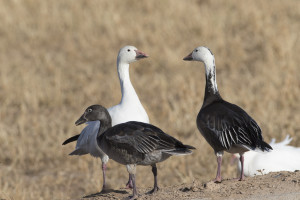 Duck hunters know a lot about the snow goose, but there are more than likely still plenty of interesting facts they have never concerned themselves with. For the casual observer, these birds are just another breed of waterfowl that they see at different times of the year. Whether you are a hunting enthusiast or just enjoy seeing this beautiful bird in the skies, we hope you enjoy these interesting (at least we think so) facts about the snow goose!
Duck hunters know a lot about the snow goose, but there are more than likely still plenty of interesting facts they have never concerned themselves with. For the casual observer, these birds are just another breed of waterfowl that they see at different times of the year. Whether you are a hunting enthusiast or just enjoy seeing this beautiful bird in the skies, we hope you enjoy these interesting (at least we think so) facts about the snow goose!
- The snow goose is one of the more intelligent birds we see. In fact, it is quite common to see older birds among the flock simply because they do not fall for common hunting tactics (the oldest goose on record thus far was over 27 years old!). These birds assimilate to the conditions and while you may be able to trick the flock the first time through the area, you will often have to change tactics to lure them in on future days.
- While many geese we see are completely white, you will occasionally see a goose with blue coloring. And yes, they are rare. In fact, the blue coloring actually comes from a single gene. These blue geese are a bit more common in the Midwest, but they are far from the norm.
- Snow geese feed differently than the others do like Canadian Goose . For the most part, Canadian geese will more or less trim the vegetation and leave the roots completely alone. Where snow geese tend to shred and eat the roots of the plant as well as the seed and stems.
- The shells of the eggs of the snow goose stain quite easily. So, if you want to know which eggs were laid first, look for the dirtiest egg.
- From the cute pictures of baby geese (goslings), you would think it a safe assumption that these birds are almost helpless when they are born, but that is hardly the case. Goslings will actually walk as much as 50 miles early on in life with their parents to find better grounds. The birds develop very quickly and within only a few days, are capable of maintaining their own body temperature.
- Unless the female is actually incubating, she will forage for about 18 hours a day when on the breeding grounds.
- Geese generate as many as 15 droppings per hour because food takes as little as an hour to process through the digestive tract.
- When the birds arrive at their feeding grounds, they actually have lookouts that scan the area for predators. If a threat is sighted, the lookout will send out a warning to the feeding birds.
- The courting ritual of the snow goose occurs during the females second year. Like penguins, snow geese choose their mate for life, so this is a very serious time. The male will court the female by doing dances and calls in an effort to sweep her off her feet. If she does not show any interest, he takes his wooing elsewhere. If she does show interest, they will spend several days together, mirroring each others activities and sharing food, culminating in mating and a nest of three to five eggs.












